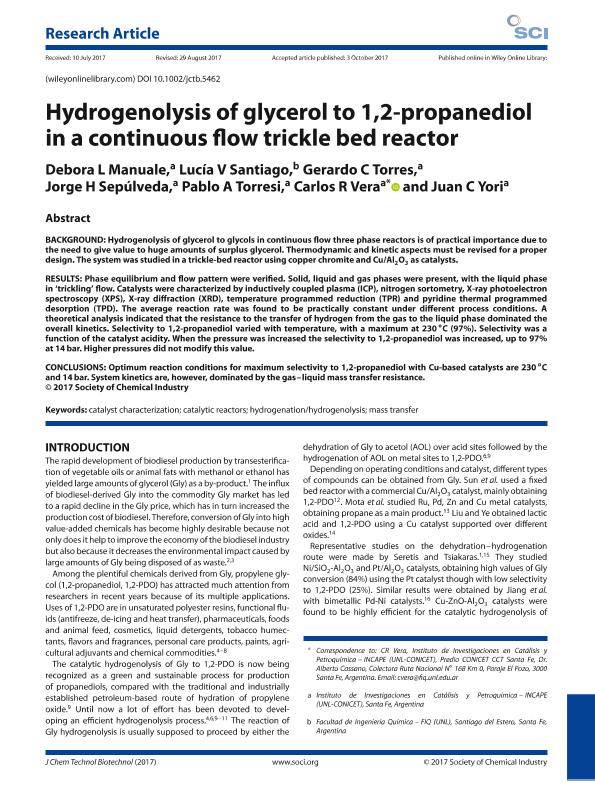Mostrar el registro sencillo del ítem
dc.contributor.author
Manuale, Débora Laura

dc.contributor.author
Santiago, Lucía
dc.contributor.author
Torres, Gerardo Carlos

dc.contributor.author
Sepulveda Flores, Jorge Humberto

dc.contributor.author
Torresi, Pablo Antonio

dc.contributor.author
Vera, Carlos Roman

dc.contributor.author
Yori, Juan Carlos

dc.date.available
2018-11-01T19:37:29Z
dc.date.issued
2018-04
dc.identifier.citation
Manuale, Débora Laura; Santiago, Lucía; Torres, Gerardo Carlos; Sepulveda Flores, Jorge Humberto; Torresi, Pablo Antonio; et al.; Hydrogenolysis of glycerol to 1,2-propanediol in a continuous flow trickle bed reactor; John Wiley & Sons Ltd; Journal of Chemical Technology and Biotechnology; 93; 4; 4-2018; 1050-1064
dc.identifier.issn
0268-2575
dc.identifier.uri
http://hdl.handle.net/11336/63492
dc.description.abstract
BACKGROUND: Hydrogenolysis of glycerol to glycols in continuous flow three phase reactors is of practical importance due to the need to give value to huge amounts of surplus glycerol. Thermodynamic and kinetic aspects must be revised for a proper design. The system was studied in a trickle-bed reactor using copper chromite and Cu/Al2O3 as catalysts. RESULTS: Phase equilibrium and flow pattern were verified. Solid, liquid and gas phases were present, with the liquid phase in ´trickling´ flow. Catalysts were characterized by inductively coupled plasma (ICP), nitrogen sortometry, X-ray photoelectron spectroscopy (XPS), X-ray diffraction (XRD), temperature programmed reduction (TPR) and pyridine thermal programmed desorption (TPD). The average reaction rate was found to be practically constant under different process conditions. A theoretical analysis indicated that the resistance to the transfer of hydrogen from the gas to the liquid phase dominated the overall kinetics. Selectivity to 1,2-propanediol varied with temperature, with a maximum at 230°C (97%). Selectivity was a function of the catalyst acidity. When the pressure was increased the selectivity to 1,2-propanediol was increased, up to 97% at 14bar. Higher pressures did not modify this value. CONCLUSIONS: Optimum reaction conditions for maximum selectivity to 1,2-propanediol with Cu-based catalysts are 230°C and 14bar. System kinetics are, however, dominated by the gas-liquid mass transfer resistance.
dc.format
application/pdf
dc.language.iso
eng
dc.publisher
John Wiley & Sons Ltd

dc.rights
info:eu-repo/semantics/openAccess
dc.rights.uri
https://creativecommons.org/licenses/by-nc-sa/2.5/ar/
dc.subject
Catalyst Characterization
dc.subject
Catalytic Reactors
dc.subject
Hydrogenation/Hydrogenolysis
dc.subject
Mass Transfer
dc.subject.classification
Otras Ingeniería Química

dc.subject.classification
Ingeniería Química

dc.subject.classification
INGENIERÍAS Y TECNOLOGÍAS

dc.title
Hydrogenolysis of glycerol to 1,2-propanediol in a continuous flow trickle bed reactor
dc.type
info:eu-repo/semantics/article
dc.type
info:ar-repo/semantics/artículo
dc.type
info:eu-repo/semantics/publishedVersion
dc.date.updated
2018-10-23T18:41:10Z
dc.journal.volume
93
dc.journal.number
4
dc.journal.pagination
1050-1064
dc.journal.pais
Reino Unido

dc.journal.ciudad
Londres
dc.description.fil
Fil: Manuale, Débora Laura. Consejo Nacional de Investigaciones Científicas y Técnicas. Centro Científico Tecnológico Conicet - Santa Fe. Instituto de Investigaciones en Catálisis y Petroquímica "Ing. José Miguel Parera". Universidad Nacional del Litoral. Instituto de Investigaciones en Catálisis y Petroquímica "Ing. José Miguel Parera"; Argentina
dc.description.fil
Fil: Santiago, Lucía. Universidad Nacional del Litoral; Argentina
dc.description.fil
Fil: Torres, Gerardo Carlos. Consejo Nacional de Investigaciones Científicas y Técnicas. Centro Científico Tecnológico Conicet - Santa Fe. Instituto de Investigaciones en Catálisis y Petroquímica "Ing. José Miguel Parera". Universidad Nacional del Litoral. Instituto de Investigaciones en Catálisis y Petroquímica "Ing. José Miguel Parera"; Argentina
dc.description.fil
Fil: Sepulveda Flores, Jorge Humberto. Consejo Nacional de Investigaciones Científicas y Técnicas. Centro Científico Tecnológico Conicet - Santa Fe. Instituto de Investigaciones en Catálisis y Petroquímica "Ing. José Miguel Parera". Universidad Nacional del Litoral. Instituto de Investigaciones en Catálisis y Petroquímica "Ing. José Miguel Parera"; Argentina
dc.description.fil
Fil: Torresi, Pablo Antonio. Consejo Nacional de Investigaciones Científicas y Técnicas. Centro Científico Tecnológico Conicet - Santa Fe. Instituto de Investigaciones en Catálisis y Petroquímica "Ing. José Miguel Parera". Universidad Nacional del Litoral. Instituto de Investigaciones en Catálisis y Petroquímica "Ing. José Miguel Parera"; Argentina
dc.description.fil
Fil: Vera, Carlos Roman. Consejo Nacional de Investigaciones Científicas y Técnicas. Centro Científico Tecnológico Conicet - Santa Fe. Instituto de Investigaciones en Catálisis y Petroquímica "Ing. José Miguel Parera". Universidad Nacional del Litoral. Instituto de Investigaciones en Catálisis y Petroquímica "Ing. José Miguel Parera"; Argentina
dc.description.fil
Fil: Yori, Juan Carlos. Consejo Nacional de Investigaciones Científicas y Técnicas. Centro Científico Tecnológico Conicet - Santa Fe. Instituto de Investigaciones en Catálisis y Petroquímica "Ing. José Miguel Parera". Universidad Nacional del Litoral. Instituto de Investigaciones en Catálisis y Petroquímica "Ing. José Miguel Parera"; Argentina
dc.journal.title
Journal of Chemical Technology and Biotechnology

dc.relation.alternativeid
info:eu-repo/semantics/altIdentifier/url/www.wiley.com/WileyCDA/WileyTitle/productCd-JCTB.html
dc.relation.alternativeid
info:eu-repo/semantics/altIdentifier/doi/http://dx.doi.org/10.1002/jctb.5462
Archivos asociados
